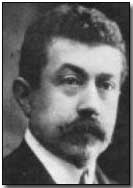Who's Who - Paul Painleve
 Paul Painleve (1863-1933), the
celebrated mathematician and politician, was the shortest serving French
Prime Minister of the war - at just two months - and easily its least
experienced.
Paul Painleve (1863-1933), the
celebrated mathematician and politician, was the shortest serving French
Prime Minister of the war - at just two months - and easily its least
experienced.
Painleve's mathematical achievements saw him teach as a professor at the Sorbonne, the Ecole Polytechnique and at the University of Lille. He won the Grand Prix des Sciences Mathematiques in 1890 and was elected to the Academy of Sciences in 1900.
In political terms Painleve entered parliament rather late in life, at the age of 43 in 1906. There he quickly established himself at the head of the small Republican-Socialist group.
Taking a keen interest in the military conduct of the war from the start - he was especially interested in aviation and was Wilbur Wright's first French passenger in 1908 - Painleve was both an ardent 'easterner' (which led him to aggressively champion General Sarrail's cause during the summer of 1915) and a firm believer in Petain's policy of defensive strategy.
Brought into Aristide Briand's cabinet in October 1915 - his first spell in office - Painleve was given the Education ministry. He nevertheless continued to display keen interest in military matters, and he was an earlier critic of Joffre than most.
Appointed War Minister in Alexandre Ribot's new ministry, Painleve displayed outright opposition to Commander in Chief Robert Nivelle's planned Aisne offensive (the 'Nivelle Offensive'), yet found himself unable to abort it - plans were too far advanced and Nivelle would have resigned, sparking a political crisis.
With the inevitable and hugely costly failure of Nivelle's offensive in April-May 1917, Painleve was able to appoint Petain first Chief of Staff in April and then, in May, Commander in Chief. He worked with Petain in bringing about the recuperation of the French army following the widespread mutinies that following Nivelle's patently unsuccessful offensive. (Click here to read Painleve's public statement following the Aisne debacle, dated 7 July 1917.)
With the fall of Ribot's government over the sacking of Louis Malvy as Interior Minister (the radical block withdrew their parliamentary support in protest), Painleve was invited to serve as Prime Minister on 12 September 1917.
It was short lived; opposing political forces tore the coalition cabinet apart, forcing Painleve's resignation on 13 November. His replacement, Georges Clemenceau, chose not to include Painleve in his own cabinet; thus Painleve saw out the remainder of the war on the political sidelines.
He served again as premier from April-November 1925 during the French financial crisis and as Minister of War from 1925-29, during which time he sponsored the construction of the Maginot Line that was supposed to provide a defence against Germany in the next war; in the event it was never used.
As its chief, Painleve inaugurated the Air Ministry in 1930, fulfilling a lifelong interest in aviation. He remained with the ministry (twice as its chief) until his retirement in 1932.
Paul Painleve died in Paris on 29 October 1933 at the age of 69.
The "Blue Max" was a reference to the prestigious German Pour le Merite medal.
- Did you know?
